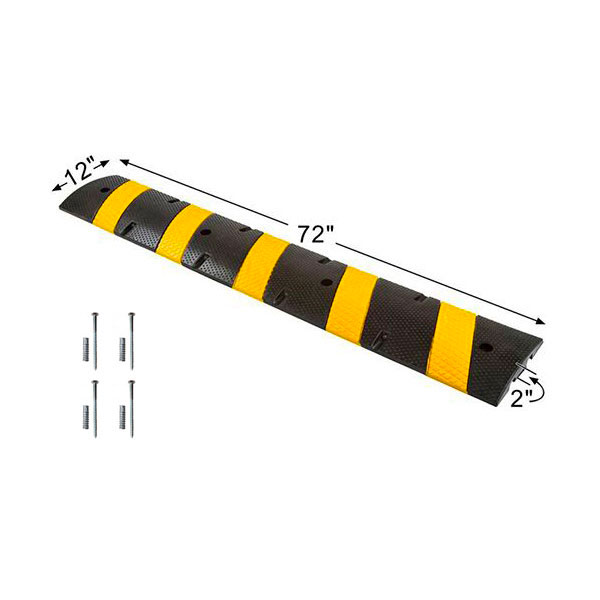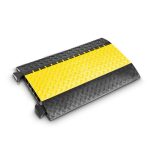Introduction to speed bumps
Speed bumps are a common traffic calming measure used on roads and highways to reduce vehicle speed and improve road safety. They are typically installed in areas where there is a need to slow down traffic, such as residential neighborhoods, school zones, and parking lots. The purpose of speed bumps is to force drivers to slow down and pay attention to their surroundings, thereby reducing the risk of accidents and promoting safe driving habits. In this article, we will explore the various benefits of speed bumps and how they contribute to road safety.
Purpose of speed bumps
The purpose of speed bumps is to slow down vehicles and improve road safety. Speed bumps are designed to reduce the speed of vehicles by creating a physical barrier on the road. They are typically placed in areas where speeding is a concern, such as residential neighborhoods, school zones, and parking lots. By forcing drivers to slow down, speed bumps help to prevent accidents and protect pedestrians, cyclists, and other road users. Additionally, speed bumps can also help to calm traffic and create a more peaceful and quiet environment in residential areas. Overall, the purpose of speed bumps is to create a safer and more controlled driving environment.
Benefits of speed bumps
Speed bumps provide several benefits that contribute to road safety. Firstly, they help in reducing the speed of vehicles, especially in residential areas or near schools, where pedestrian safety is a primary concern. By forcing drivers to slow down, speed bumps prevent accidents and potential injuries. Additionally, speed bumps also act as a visual reminder for drivers to be cautious and attentive while driving. This helps in increasing awareness and promoting a safer driving environment. Lastly, speed bumps can help in controlling traffic flow by encouraging drivers to follow speed limits, reducing congestion, and creating a smoother traffic pattern. Overall, the presence of speed bumps on roads plays a crucial role in enhancing road safety and protecting both pedestrians and drivers.
Effectiveness of Speed Bumps
Reduction of speeding
Speed bumps are an effective measure for the reduction of speeding on roads. By introducing these physical obstacles, drivers are forced to slow down, promoting safer driving behavior. The presence of speed bumps serves as a visual reminder to motorists to adhere to the speed limit and exercise caution. Studies have shown that areas with speed bumps experience a significant decrease in average vehicle speeds, thus reducing the likelihood of accidents and improving overall road safety. Additionally, speed bumps are particularly beneficial in residential areas and school zones, where the protection of pedestrians and vulnerable road users is of utmost importance. Therefore, the implementation of speed bumps plays a crucial role in the reduction of speeding and enhancing road safety.
Improvement of pedestrian safety
Speed bumps play a crucial role in improving pedestrian safety on the roads. By strategically placing speed bumps in areas with high foot traffic, drivers are forced to slow down and pay more attention to their surroundings. This helps to reduce the risk of accidents involving pedestrians, as it gives them more time to react and cross the road safely. Furthermore, speed bumps also serve as a visual reminder for drivers to be cautious and aware of their surroundings, especially in areas where children or elderly individuals may be present. Overall, the implementation of speed bumps contributes significantly to the improvement of pedestrian safety, creating a safer environment for everyone on the road.
Impact on traffic flow
Speed bumps have a significant impact on traffic flow. These raised structures are designed to slow down vehicles and enforce speed limits, ultimately contributing to road safety. By introducing obstacles on the road, speed bumps force drivers to reduce their speed, making it safer for pedestrians and other road users. Additionally, speed bumps can help control traffic congestion in areas with high vehicle volume. However, it is important to strike a balance between road safety and the smooth flow of traffic, as excessive or poorly designed speed bumps can cause inconvenience and frustration for drivers. Therefore, careful planning and consideration are necessary when implementing speed bumps to ensure they effectively enhance road safety without causing unnecessary disruptions to traffic flow.
Design and Placement of Speed Bumps
Types of speed bumps
There are several types of speed bumps that are commonly used to enhance road safety. One type is the traditional speed bump, which is a raised platform that spans the width of the road. These bumps are typically made of rubber or asphalt and are designed to slow down vehicles by forcing them to reduce their speed. Another type is the speed hump, which is a longer and more gradual raised surface. Speed humps are often used in residential areas to encourage drivers to slow down without causing discomfort or damage to vehicles. Finally, there are also speed cushions, which are raised platforms with gaps in between. These cushions are designed to allow emergency vehicles and larger vehicles, such as buses, to pass through without slowing down significantly, while still effectively slowing down other vehicles. Overall, the different types of speed bumps play a crucial role in promoting road safety by reducing vehicle speeds and improving driver awareness.
Factors to consider in design
When designing speed bumps, there are several factors that need to be considered. First and foremost, the height and shape of the speed bump should be carefully determined to ensure that it effectively slows down vehicles without causing discomfort or damage. Additionally, the placement of speed bumps is crucial, as they should be strategically located in areas where speeding is a concern, such as near schools or residential areas. Furthermore, the visibility of speed bumps is essential for drivers to anticipate and react to them in a timely manner. Lastly, the materials used in the construction of speed bumps should be durable and weather-resistant to withstand constant use and exposure to the elements. By taking these factors into account, the design of speed bumps can contribute significantly to road safety by effectively reducing speeding and promoting a safer driving environment.
Proper placement for maximum effectiveness
Proper placement of speed bumps is crucial for maximizing their effectiveness in improving road safety. It is important to strategically position speed bumps in areas where they can have the greatest impact on reducing speeding and promoting driver awareness. High-risk locations such as residential areas, school zones, and pedestrian crossings should be prioritized for speed bump installation. Additionally, careful consideration should be given to the spacing between speed bumps to ensure a smooth and comfortable driving experience while still effectively slowing down vehicles. By placing speed bumps in the right locations and maintaining proper spacing, we can create safer roads and encourage responsible driving behavior.
Challenges and Concerns
Noise and vibration
Noise and vibration are important factors to consider when discussing the impact of speed bumps on road safety. Speed bumps can generate significant noise and vibrations, especially when vehicles pass over them at high speeds. This can be particularly disruptive in residential areas, where excessive noise can disturb the peace and tranquility of the neighborhood. Additionally, prolonged exposure to vibrations caused by speed bumps can have negative effects on the structural integrity of vehicles, leading to potential maintenance issues and increased costs for drivers. Therefore, it is crucial to carefully design and implement speed bumps to minimize noise and vibration levels while still effectively slowing down vehicles and ensuring road safety.
Potential damage to vehicles
Potential damage to vehicles is one of the main concerns when it comes to speed bumps. These raised structures on the road can cause significant harm to vehicles if not designed and installed properly. The abrupt change in elevation can lead to scraping or bottoming out of the vehicle’s undercarriage, resulting in damage to the exhaust system, suspension, and other components. Moreover, if a vehicle approaches a speed bump at an excessive speed, it can cause even more severe damage, such as punctured tires or broken axles. Therefore, it is crucial for authorities to consider the potential damage to vehicles and ensure that speed bumps are constructed in a way that minimizes these risks while still effectively slowing down traffic.
Emergency vehicle access
Emergency vehicle access is a critical aspect to consider when implementing speed bumps on roads. While speed bumps are effective in reducing speeding and promoting road safety, they can also hinder the progress of emergency vehicles. It is crucial to strike a balance between the need for speed control and ensuring unimpeded access for emergency vehicles. Proper planning and design of speed bumps, such as incorporating gaps or alternative routes for emergency vehicles, can help maintain the safety benefits of speed bumps while allowing quick and efficient access for emergency services. This ensures that the overall goal of road safety is achieved without compromising the timely response to emergencies.
Alternative Solutions
Speed humps
Speed humps are an effective traffic calming measure that helps to reduce vehicle speed and improve road safety. These raised platforms are strategically placed on roads to slow down drivers and encourage them to drive at a safe speed. By forcing drivers to slow down, speed humps help to prevent accidents and minimize the severity of any potential collisions. They are particularly beneficial in residential areas, school zones, and areas with high pedestrian activity, where the safety of pedestrians and other road users is of utmost importance. Additionally, speed humps also contribute to noise reduction and improved air quality by reducing excessive speeding and aggressive driving behaviors. Overall, speed humps play a crucial role in promoting road safety and creating a safer environment for everyone on the road.
Traffic calming measures
Traffic calming measures are essential for ensuring the safety of road users. One such measure that has proven to be effective is the installation of speed bumps. Speed bumps are designed to slow down vehicles, forcing drivers to reduce their speed and be more cautious while navigating through residential areas, school zones, and other high-pedestrian traffic areas. By implementing speed bumps, communities can significantly reduce the risk of accidents and enhance road safety. These traffic calming measures not only protect pedestrians but also encourage drivers to be more aware of their surroundings, ultimately creating a safer environment for everyone.
Technological advancements
Technological advancements have played a significant role in improving road safety and speed bump effectiveness. With the introduction of advanced sensors and monitoring systems, speed bumps can now be equipped with smart technology that detects the speed of approaching vehicles and adjusts its height accordingly. This not only ensures a smoother driving experience but also reduces the risk of accidents caused by drivers failing to slow down in time. Moreover, technological advancements have also led to the development of innovative materials that make speed bumps more durable and resistant to wear and tear. Overall, these technological advancements have greatly contributed to enhancing road safety and making speed bumps a more efficient tool for traffic control.
Summary of key points
In summary, speed bumps play a crucial role in enhancing road safety. They are designed to slow down vehicles, reducing the risk of accidents and promoting responsible driving behavior. By forcing drivers to decrease their speed, speed bumps help prevent excessive speeding in residential areas, school zones, and other high-risk areas. Additionally, they serve as a visual reminder for drivers to be cautious and alert while navigating through potentially dangerous areas. Overall, speed bumps contribute significantly to creating safer roads and protecting the well-being of both pedestrians and drivers.
Importance of speed bumps in road safety
Speed bumps play a crucial role in ensuring road safety. They are strategically placed on roads to slow down vehicles and reduce the risk of accidents. By forcing drivers to reduce their speed, speed bumps help prevent reckless driving and encourage responsible behavior on the road. Additionally, speed bumps are particularly effective in areas with high pedestrian traffic, such as residential neighborhoods and school zones, as they provide an added layer of protection for pedestrians. Their presence serves as a constant reminder for drivers to be cautious and aware of their surroundings, ultimately contributing to a safer road environment for everyone.
Future considerations
In addition to the current benefits of speed bumps in enhancing road safety, it is crucial to consider future advancements in this area. With the rapid development of technology, there is a potential for innovative solutions that can further improve road safety. For instance, the integration of smart sensors in speed bumps could provide real-time data on vehicle speed and behavior, allowing authorities to identify high-risk areas and implement targeted measures. Moreover, the use of sustainable materials in the construction of speed bumps can contribute to environmental conservation and reduce maintenance costs. As we look ahead, it is important to explore these future considerations and adapt our approach to ensure road safety continues to evolve and meet the changing needs of our communities.
Stop Speeding, Start Safety: Your Guide to Effective Traffic Calming
Speeding is a major threat to pedestrian and driver safety, especially in vulnerable areas like neighborhoods, schools, and parking lots. Unimat Traffic offers a comprehensive range of speed bumps designed to effectively slow down vehicles and create safer environments for everyone.
Understanding Speed Bumps:
- More than just rubber: While rubber bumps are common, we offer various materials like high-strength concrete for durability and flexibility in different settings.
- How they work: By creating controlled bumps, speed bumps force vehicles to slow down, reducing the risk of accidents and injuries.
- Why they matter: Speed bumps are a crucial tool for traffic calming, protecting pedestrians, children, and drivers alike.
Unimat Speed Bump Solutions:
- For every need: We offer a variety of speed bumps for concrete, asphalt, or even portable applications. Choose from standard, curb mount, or modular options to suit your specific requirements.
- Safety first: Our speed bumps are engineered to be effective yet gentle, minimizing impact on regular traffic flow while ensuring emergency vehicles can pass safely.
- Durable and visible: We use high-quality materials and bright markings for long-lasting performance and optimal visibility, even in low-light conditions.
- Easy installation: Our speed bumps are designed for simple and efficient installation, saving you time and effort.
Beyond the Product:
- Expert guidance: Our team is here to help you choose the right speed bump for your needs and ensure proper installation.
- Competitive pricing: We offer high-quality solutions at affordable prices, ensuring value for your investment.
- Commitment to safety: We prioritize safety in everything we do, contributing to a safer and more controlled traffic environment.
Ready to create a safer community?
- Browse our selection: Explore our wide range of speed bumps and find the perfect solution for your needs.
- Contact us: Our experts are happy to answer your questions and provide a free quote.
- Special offers: Check out our current promotions and discounts on speed bumps.
Unimat Traffic: Your partner for safer roads and happier communities.







